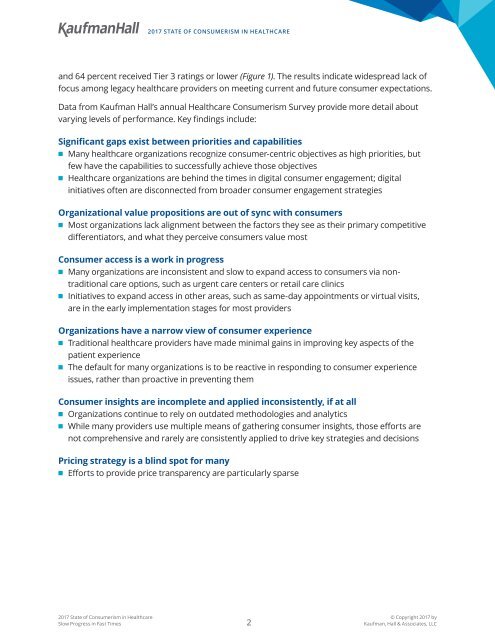2017 State of Consumerism in Healthcare_final (1)
Create successful ePaper yourself
Turn your PDF publications into a flip-book with our unique Google optimized e-Paper software.
<strong>2017</strong> STATE OF CONSUMERISM IN HEALTHCARE<br />
and 64 percent received Tier 3 rat<strong>in</strong>gs or lower (Figure 1). The results <strong>in</strong>dicate widespread lack <strong>of</strong><br />
focus among legacy healthcare providers on meet<strong>in</strong>g current and future consumer expectations.<br />
Data from Kaufman Hall’s annual <strong>Healthcare</strong> <strong>Consumerism</strong> Survey provide more detail about<br />
vary<strong>in</strong>g levels <strong>of</strong> performance. Key f<strong>in</strong>d<strong>in</strong>gs <strong>in</strong>clude:<br />
Significant gaps exist between priorities and capabilities<br />
◾◾<br />
Many healthcare organizations recognize consumer-centric objectives as high priorities, but<br />
few have the capabilities to successfully achieve those objectives<br />
◾◾<br />
<strong>Healthcare</strong> organizations are beh<strong>in</strong>d the times <strong>in</strong> digital consumer engagement; digital<br />
<strong>in</strong>itiatives <strong>of</strong>ten are disconnected from broader consumer engagement strategies<br />
Organizational value propositions are out <strong>of</strong> sync with consumers<br />
◾◾<br />
Most organizations lack alignment between the factors they see as their primary competitive<br />
differentiators, and what they perceive consumers value most<br />
Consumer access is a work <strong>in</strong> progress<br />
◾◾<br />
Many organizations are <strong>in</strong>consistent and slow to expand access to consumers via nontraditional<br />
care options, such as urgent care centers or retail care cl<strong>in</strong>ics<br />
◾◾<br />
Initiatives to expand access <strong>in</strong> other areas, such as same-day appo<strong>in</strong>tments or virtual visits,<br />
are <strong>in</strong> the early implementation stages for most providers<br />
Organizations have a narrow view <strong>of</strong> consumer experience<br />
◾◾<br />
Traditional healthcare providers have made m<strong>in</strong>imal ga<strong>in</strong>s <strong>in</strong> improv<strong>in</strong>g key aspects <strong>of</strong> the<br />
patient experience<br />
◾◾<br />
The default for many organizations is to be reactive <strong>in</strong> respond<strong>in</strong>g to consumer experience<br />
issues, rather than proactive <strong>in</strong> prevent<strong>in</strong>g them<br />
Consumer <strong>in</strong>sights are <strong>in</strong>complete and applied <strong>in</strong>consistently, if at all<br />
◾◾<br />
Organizations cont<strong>in</strong>ue to rely on outdated methodologies and analytics<br />
◾◾<br />
While many providers use multiple means <strong>of</strong> gather<strong>in</strong>g consumer <strong>in</strong>sights, those efforts are<br />
not comprehensive and rarely are consistently applied to drive key strategies and decisions<br />
Pric<strong>in</strong>g strategy is a bl<strong>in</strong>d spot for many<br />
◾◾<br />
Efforts to provide price transparency are particularly sparse<br />
<strong>2017</strong> <strong>State</strong> <strong>of</strong> <strong>Consumerism</strong> <strong>in</strong> <strong>Healthcare</strong><br />
Slow Progress <strong>in</strong> Fast Times<br />
2<br />
© Copyright <strong>2017</strong> by<br />
Kaufman, Hall & Associates, LLC


